Mattress Care
February 2023How to Get Stains Out of Your Mattress
The expert team at John Ryan regularly gets asked about the best way to tackle mattress stains and, whilst we’ve written about it on our site before, we realised that we hadn’t put together a comprehensive guide. So, without further ado, here is the only guide to mattress stains and how to clean them that you’re ever likely to need.
- What Causes Mattress Stains?
- Regular Mattress Care
- How to Clean Your Mattress
- How to Remove Mattress Stains
- How to Get Smells Out of Mattress
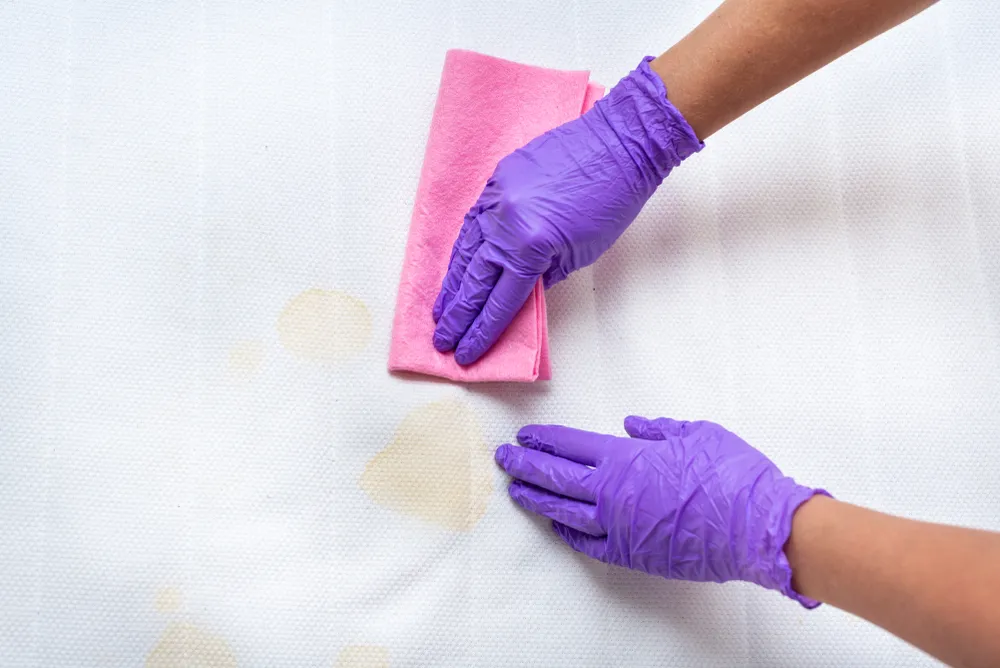
What Causes Mattress Stains?
Lots of things can cause mattress stains. You could spill something, a bodily fluid may come into contact with a mattress, or environmental factors like dust and dirt can (quite literally!) make their mark. Common substances that stain mattresses include sweat, urine, blood, and stray food or drink. Even dust, pet hair, and pollen can lead to stains or discolouration on a mattress as – left unchecked – they can accumulate.
If enough time passes, substances like these can seep into a mattress and leave stains that are very difficult to remove. However, the foremost weapon you have in your arsenal to combat mattress stains is not actually a secret weapon to tackle them as they occur: it’s prevention via a regular mattress cleaning and maintenance routine!
Regular Mattress Care
Regular mattress cleaning is essential for preventing stains from building up over time (like the aforementioned dust, pet hair or pollen accumulation). This type of cleaning helps to remove stains before they become deeply embedded in your mattress’s fibres. If you keep on top of cleaning in this way, you stand a better chance of being able to make a difference in the long term.
Added to that, even simple steps like vacuuming your mattress or using a mattress protector can help to keep your sleeping space free from unsightly stains. As we’ve already said, we spend a significant portion of our lives in bed, so it’s hugely important to keep our mattresses clean and free from any contaminants that can negatively impact our health.
Top Tip: Vacuum your mattress using a small upholstery attachment, and do so in vertical lines from left to right, then horizontally from top to bottom.
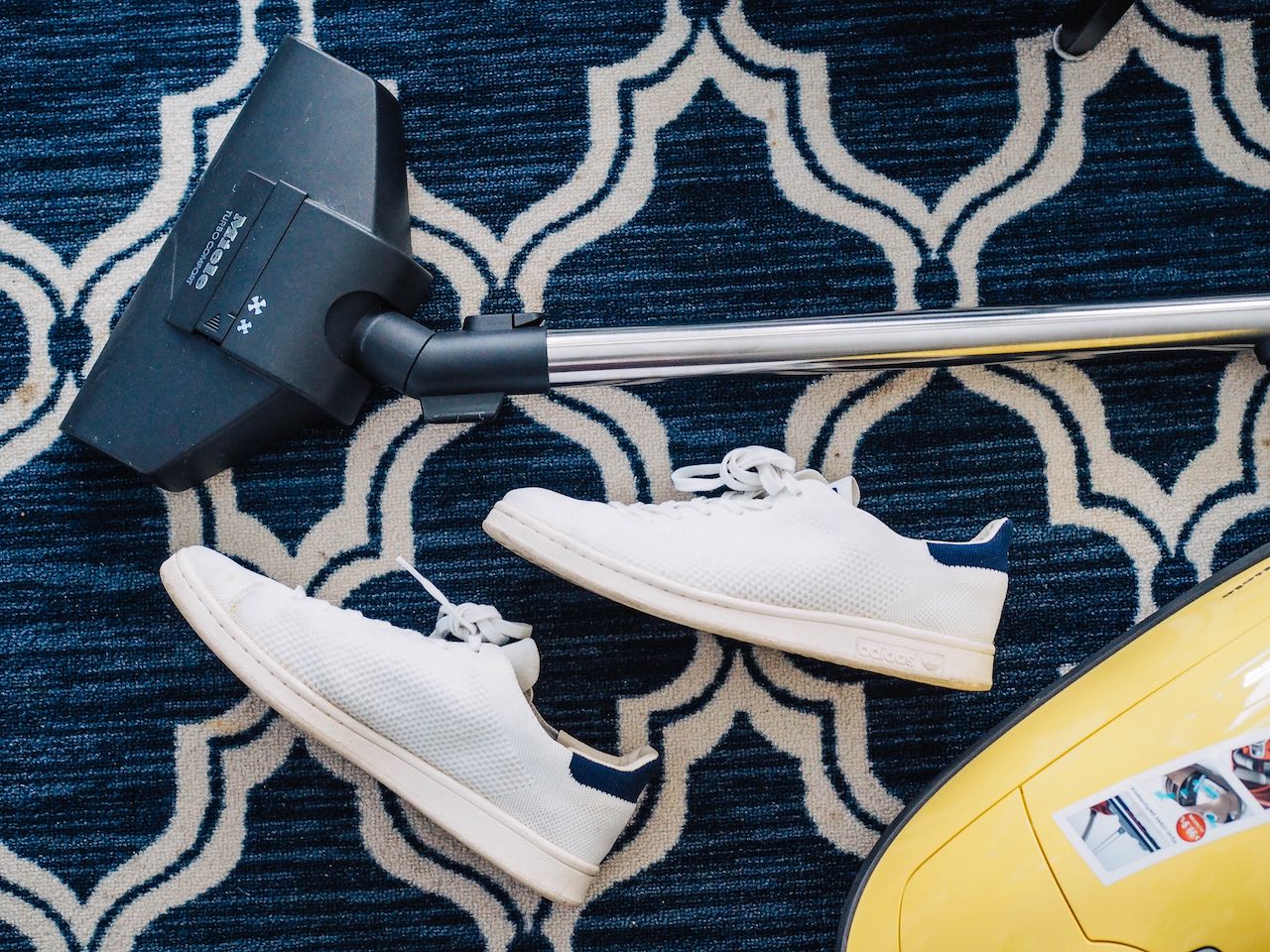
How to Clean Your Mattress
Cleaning your mattress doesn’t have to be daunting. In fact, just 4 simple steps can lead to much better mattress hygiene.
- Remove any bedding and vacuum the surface of your mattress.
- Use a mattress protector; it’s your number #1 guard against sweat stains!
- Regularly rotate your mattress to prevent uneven wear and tear.
- Don’t forget to dust and vacuum under the bed base/frame.
You can also sponge any emerging stains. If a stain isn’t embedded, a mild cleaning solution applied to a clean cloth will usually do the job.
Why You Need to Clean a Mattress
As we’ve said, cleaning a mattress regularly helps to maintain a healthy sleeping environment, and thus minimise the chance of associated health problems. A clean mattress is especially vital for anyone with allergies or respiratory issues. However, it’s also true that sleeping on a clean mattress just feels nicer! Most people (if not all people) will sleep much better if they’re comfortable, so it’s highly advisable to clean your mattress for that reason alone. Finally, regular cleaning also prolongs the lifespan of a mattress, saving you from unnecessarily buying a brand new one.
How Often Should You Clean a Mattress?
How often you clean your mattress depends on a few different factors, including your personal hygiene, any allergies or health concerns you may have, and also the overall condition of your mattress. As a general rule, it’s worth cleaning your mattress at least once every six months. However, if you suffer from allergies or respiratory issues, or if a mishap has occurred that might stain your mattress, it’s advisable that you clean it a lot more regularly than this.
Cleaning your mattress is also a fantastic opportunity to spot any signs of damage, such as sagging or tears. Being proactive and noting them early gives you the chance of addressing wear and tear before it gets even worse. In doing so, you’re taking care of your sleeping surface and holding back that dreaded “point of no return”, when your mattress just isn’t comfortable any more.
How to Take Care of Your Mattress
Aside from a regular cleaning routine, there are several other ways to take care of your mattress and get as much use out of it as possible:
- Rotate/flip your mattress every month. This distributes wear more evenly and stops sagging/indentations from building up in one particular area.
- Avoid bouncing on your mattress. Too much exuberance can damage the springs or the materials.
- Follow any manufacturer’s guidelines for your specific mattress. Weight limits or maintenance advice are there to make sure you get the most from your bedding, so don’t treat them as optionals!
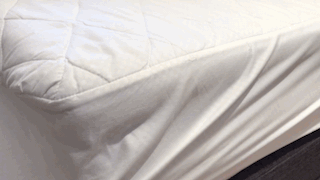
Do You Need a Mattress Protector/Topper?
We get asked this question a lot and, as we’ve already mentioned it, we thought now would be a good time to reinforce that you really should have a mattress protector! A topper might be optional, depending on how comfortable you find your mattress to be, but a protector is a necessity. Mattress toppers or protectors have many benefits:
- Protection: Both mattress toppers and protectors shield your mattress from spills, stains, and other types of damage. Replacing a topper or protector is much cheaper than replacing a mattress!
- Comfort: A mattress topper can help to add an extra layer of comfort to a mattress that you find to be a little too firm or lacking in support.
- Hygiene: A mattress topper or protector can help to keep your mattress clean and hygienic, preventing any buildup of dust mites, bacteria, and other allergens that could trigger health concerns.
If you decide to use both a mattress topper and protector, then be sure to position the protector over the topper. You should also do plenty of research to make sure that whatever you buy meets your needs and is compatible with your mattress.
How Often Should You Turn Your Mattress
How often you should turn your mattress depends on its type and condition, as well as your personal sleeping habits and preferences. Some sources would recommend that you turn your mattress every 3-6 months (at least), as it helps to distribute all that wear and tear more evenly. The team at John Ryan would go further than that, and actually advise that you turn (and, if possible, rotate) your mattress on a monthly basis. However, there’s a caveat! Some low quality mattresses are designed to be used on only one side, so it’s important to check if that’s the case before you flip them. We certainly wouldn’t recommend these mattresses, although we do have some tips to improve the lifespans of one-sided mattresses if you already have one.

How to Remove Mattress Stains
So, you’ve taken care of your mattress, have followed a strict pattern of regular mattress cleaning, and yet you’ve still got a mattress stain on your hands. What next? With the right tools and techniques, it’s possible to get your bedding looking fresh and clean once again. For general mattress stains, we’d recommend the following:
- Deal with stains immediately: The instant you see a spill or stain, use a clean towel or cloth to mop up as much excess stain as possible. Don’t ever use a cloth to rub the stain, as that could push any liquids involved even further into the mattress fibres, but instead just gently “blot” the stain using compression.
- Use a cleaning solution: Stain dependent, a mild cleaning solution like baking soda and water mixed together, or a solution of laundry detergent, can help. If you do take this route, let any solution sit for 5-10 minutes after applying it.
- Blot the stain again: After the cleaning solution has had a chance to work, remove as much liquid as possible by blotting it with a clean towel or cloth.
- Dry your mattress: Dry your mattress thoroughly after cleaning it. Forgetting this step can result in a build up of mould and/or mildew. You can assist the drying process using a fan or open window, but don’t ever resort to a hairdryer or another heat source, as this could warp the fibres in your mattress.
- Vacuum the mattress: Once your mattress is dry, use a vacuum cleaner with an upholstery attachment to remove any remaining stain particles.
Top Tip: Never saturate your mattress with water or any other solution. Only ever dampen it!
The Best Mattress Stain Removers
Even the best mattress stain removers have both strengths and weaknesses, but some of the most popular options include:
- Enzyme-based cleaners: Use natural enzymes to break down stains on your mattress, making them an effective and eco-friendly option.
- Oxygen-based cleaners: Use oxygen to remove tough, set-in stains such as blood or urine.
- Baking soda: Mixed with water, this is an effective and affordable stain remover.
- Vinegar: Mixed with water, this mild stain remover can also help you to get rid of lingering odours.
- Commercial stain removers: Many commercial stain removers are specifically designed for use on mattresses. Be sure to read any labels and reviews carefully before you make use of them!
Always consider the type of stain you’re dealing with, as well as any allergies or sensitivities you may have, when you’re choosing a mattress stain remover. It’s also a good idea to test any stain remover on a small, inconspicuous area of your mattress before applying it to a stain, just to make sure that it won’t damage the material.
How to Remove Tougher Mattress Stains
For particularly tough stains, you may be best served by a steam cleaner or even a professional mattress cleaning service. This is especially true for mattresses that use delicate materials.
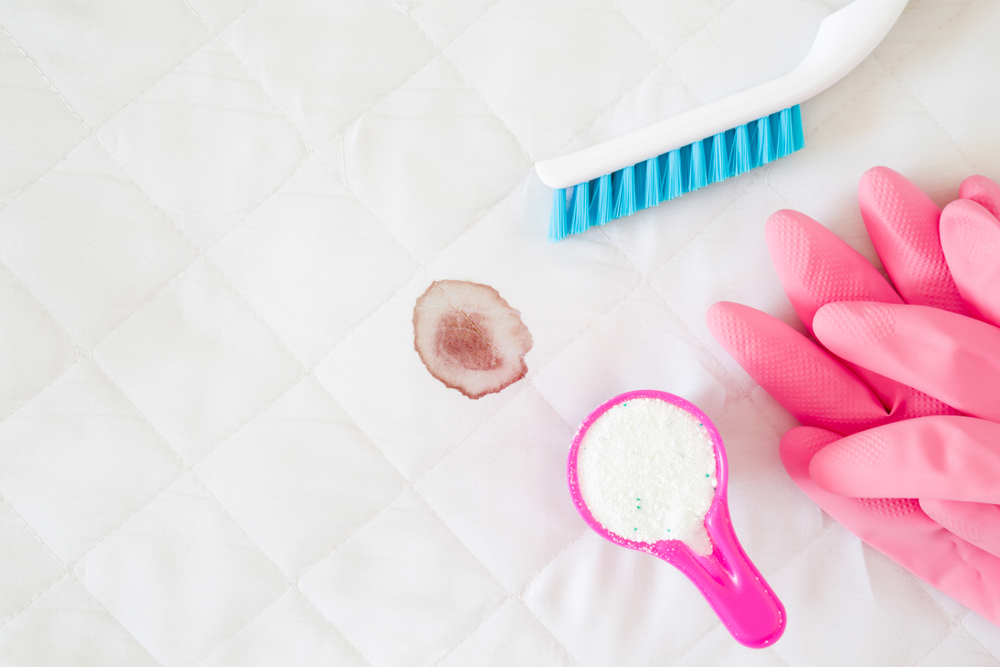
How to Get Blood Stains Out of a Mattress
You should tackle a blood stain on your mattress as quickly as possible, as they’re much easier to remove when they’re fresh.
- Use a clean, damp cloth to mop up as much of the blood as possible, but don’t rub the stain.
- Mix 1 tablespoon of liquid soap with 2 cups of cold water and gently apply it to the stain with a clean, damp cloth. Work from the outside of the stain towards the centre to avoid spreading it further.
- Dampen a second clean cloth with cold water and blot the stain to remove any excess cleaning solution. Repeat this action until the stain is no longer visible.
- Use a dry towel to absorb as much moisture as possible from the mattress. You can use ventilation from open windows or a fan to assist the drying process.
- Once your mattress is completely dry, use a vacuum cleaner with an upholstery attachment to remove any remaining residue.
If a bloodstain is proving to be stubborn, you may want to try an enzyme or an oxygen-based cleaner to help break down the blood. You can also read our dedicated guide to getting blood out of a mattress for more information.
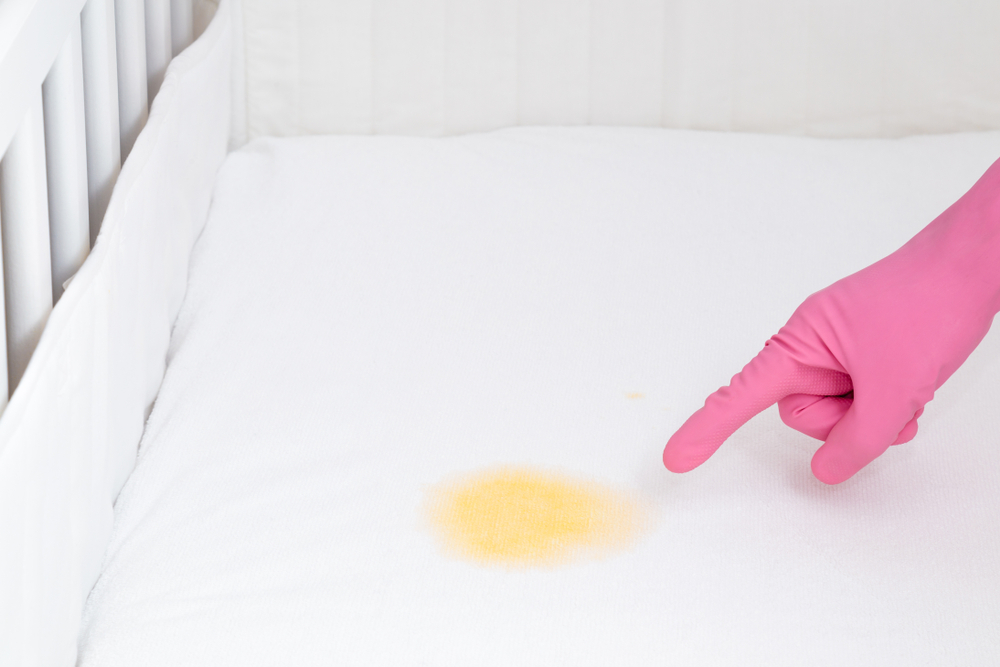
How to Get Urine Stains Out of Mattress
- Use a clean, dry towel to blot up as much of the urine as possible, without rubbing the stain.
- Mix equal parts water and white vinegar (or a purpose-designed enzyme-based cleaner) into a spray bottle. Apply it to the stain and leave it for 5-10 minutes.
- Dampen a second clean cloth with cold water and blot the stain to remove the cleaning solution. Repeat this action until the stain can no longer be seen.
- Once your mattress is completely dry, use a vacuum cleaner with an upholstery attachment to remove any remaining residue.
- Sprinkle baking soda over the area that was previously stained and leave it overnight. It’s a natural deodoriser, and will help to absorb lingering smells!
- Once your mattress is completely dry, use a vacuum cleaner with an upholstery attachment to remove any remaining residue.
If a urine stain is proving to be stubborn, you may want to repeat the cleaning process, or consider a stronger cleaning solution. We also have a dedicated guide to getting urine out of a mattress if you find yourself in need of a few more tips.
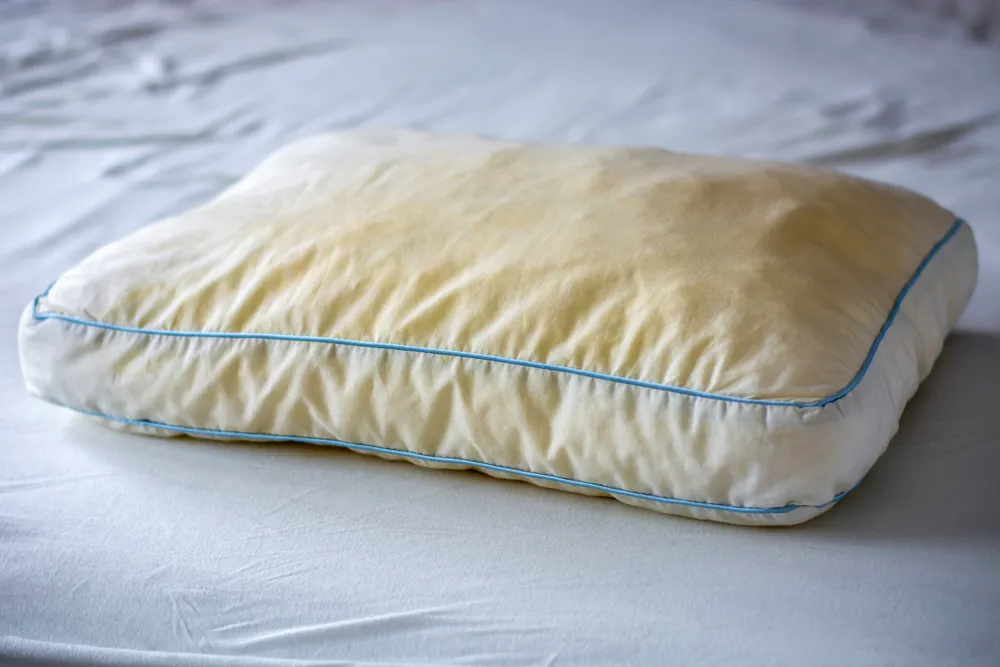
How to Remove Sweat Stains from Mattress
To reiterate: your number one weapon against sweat stains is a mattress protector. This will help to keep sweat and other fluids from seeping into your mattress in the first place.
- Before you begin to tackle a sweat stain, use a vacuum cleaner with an upholstery attachment to remove any dust or debris from your mattress.
- Mix 1/4 cup of baking soda with 1 cup of warm water to make a paste. Spread this paste over the sweat stain on your mattress and leave it for 30 minutes.
- Without using too much water, use a clean, damp cloth to gently sponge the stain in a circular motion.
- Dampen a second clean cloth with cold water and blot the stain to remove the cleaning solution. Repeat this action until the stain can no longer be seen.
- Use a dry towel to absorb as much moisture as possible from the mattress. You can use ventilation from open windows or a fan to assist the drying process.
If a sweat stain is proving to be stubborn, you may want to repeat the above process, or consider making use of a stronger cleaning solution. You can have a look at our dedicated guide to getting sweat out of a mattress for more information.

How to Get Sick Stains Out of a Mattress
Before you begin cleaning, put on a pair of disposable gloves to protect your skin!
- Use a plastic scraper or spatula to gently remove any solids from the surface of the mattress. Try your best to avoid pushing vomit deeper into the fibres.
- Use a clean, dry towel to absorb as much of the liquid as possible from the surface of the mattress. Whatever you do, don’t rub the stain!
- Mix equal parts water and white vinegar (or a purpose-designed enzyme-based cleaner) into a spray bottle. Apply it to the stain and leave it for 5-10 minutes.
- Dampen a second clean cloth with cold water and blot the stain to remove the cleaning solution. Repeat this action until the stain is no longer visible.
- Use a dry towel to absorb as much moisture as possible from the mattress. You can use ventilation from open windows or a fan to dry things out more quickly.
- Sprinkle baking soda over the area that was previously stained and leave it overnight. This will help to absorb any lingering odours.
- Once your mattress is completely dry, use a vacuum cleaner with an upholstery attachment to remove any remaining residue.
As is the case with other stains, particularly stubborn vomit stains may require a repeated cleaning process or a specialised cleaning solution. Our dedicated guide to getting vomit out of a mattress also provides some more in-depth tips.

How to Get Smells Out of Mattress
We’ve already touched on getting some lingering odours out of mattresses, but what about if the smell of a mattress is actually the primary problem? If the smell of a spill or mishap is bothering you more than a stain, we’d recommend the following process:
- Washing all of your bedding (separately to your mattress).
- Vacuuming your mattress using an upholstery attachment.
- Sprinkle a generous amount of baking soda over your mattress, paying special attention to any particularly smelly areas. Leave it on your mattress for several hours/overnight. The longer you leave it, the more effective it will be.
- Vacuum your mattress again (using an upholstery attachment).
- Mix equal parts water and white vinegar in a spray bottle. Spray the solution over your mattress, but don’t saturate it. Vinegar is a natural disinfectant that can help to kill any odour-causing bacteria and germs.
- Use a dry towel to absorb as much moisture as possible from the mattress. Again, you can use ventilation from open windows or a fan to assist the drying process, but don’t be tempted to resort to a direct heat source.
How to Freshen Up a Mattress
If your mattress isn’t particularly stained or smelly, but you think that it could benefit from a bit of freshening up, there are several simple ways to do so:
- Open your windows to allow fresh air to circulate around your room.
- Sprinkle baking soda over your mattress and let it settle for a few hours.
- Add a few drops of your favourite essential oil to a spray bottle filled with water and spray (without saturating) it over the surface of your mattress.
- Spray a fabric freshener over the surface of your mattress. Be sure to check in advance so you only make use of a product that’s suitable for mattress fabric.
It’s a good idea to freshen up your mattress every few months to keep it in tip-top shape.
When Should I Buy a New Mattress?
Eventually, everyone reaches the stage where they realise that it’s time to invest in a new mattress. If your mattress is getting stained or is losing its freshness, then that could well be a sign that it’s time to make the jump.
On average, people keep their mattresses for around 7 years, so it’s usually a significant moment when a change is required. There’s no hard and fast timeframe that should dictate when you change your mattress. In normal circumstances, a mattress that’s older than 8 years will usually be past its best, but “normal” circumstances generally assume that a mattress won’t have been well cared for. If you have a much older mattress that’s still working for you, then keep on enjoying it! Equally, if you have a younger model that’s already stained, sagging, uneven and riddled with dips, then consider buying a new one.
The most important thing to take into account is to make sure that you buy a mattress that’s right for you, and the team at John Ryan are happy to assist you towards that goal. You can find a variety of helpful tips in articles like…
- Our Guide to Buying a New Mattress – including 7 must-ask questions.
- Our Guide on How to Choose a Mattress – our ultimate bed-buying guide!
You can also call us on 0161 437 4419 to receive friendly advice that’s tailored to your specific situation, or send us an email on [email protected] to learn more.

Dreaming of the perfect nights sleep?

Ask us a question
There are over 6000 questions and answers submitted by you on all questions about mattresses and bed problems. Enter a keyword such as Vi Spring, John Lewis beds, bad back or Memory Foam and see if your question has already been answered.
If you can’t find an answer in knowledge hub, ask a new question. We aim to respond to all questions within one working day.
Newsletter
Enter your email to join our newsletter. We’ll send you occasional news and mattress expertise.
